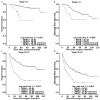Prognostic Value of Neutrophil Percentage-to-Albumin Ratio in Patients with Oral Cavity Cancer
- PMID: 36230814
- PMCID: PMC9564168
- DOI: 10.3390/cancers14194892
Prognostic Value of Neutrophil Percentage-to-Albumin Ratio in Patients with Oral Cavity Cancer
Abstract
This study investigated preoperative neutrophil percentage-to-albumin ratio (NPAR) for predicting oral cavity squamous cell carcinoma (OSCC) survival. We retrospectively analyzed 368 patients who received curative OSCC surgery between 2008 and 2017. Receiver operating characteristic curve analyses were employed to identify the optimal NPAR cutoff (16.93), and the patients were then separated into low-NPAR and high-NPAR groups. Intergroup differences in survival were determined through Kaplan−Meier analysis and log-rank tests. Disease-free survival (DFS) and overall survival (OS) predictors were identified using Cox proportional-hazards models. A nomogram integrating independent prognostic factors was proposed to increase the accuracy of OS prediction. A high NPAR (≥16.93) was associated with worse median OS and DFS than was a low NPAR (both p < 0.001); this finding was confirmed through multivariate analyses (hazard ratio (HR) for OS = 2.697, p < 0.001; and HR for DFS = 1.671, p = 0.008). The nomogram’s favorable predictive ability was confirmed by the calibration plots and concordance index (0.784). The preoperative NPAR is thus a promising prognostic biomarker in patients with OSCC after external validation in a larger cohort. Our nomogram can facilitate clinical use of the NPAR and provides accurate individualized OS predictions.
Keywords: biomarker; neutrophil percentage-to-albumin ratio; nomogram; oral cavity cancer; prognosis.
Conflict of interest statement
The authors declare no conflict of interest.
Figures




Similar articles
-
A retrospective study on the prognostic value of preoperative C-reactive protein to albumin ratio in patients with oral cavity squamous cell carcinoma.PeerJ. 2020 Jun 16;8:e9361. doi: 10.7717/peerj.9361. eCollection 2020. PeerJ. 2020. PMID: 32587804 Free PMC article.
-
Prognostic Value of CRP-Albumin-Lymphocyte (CALLY) Index in Patients Undergoing Surgery for Oral Cavity Cancer.J Cancer. 2022 Jul 27;13(10):3000-3012. doi: 10.7150/jca.74930. eCollection 2022. J Cancer. 2022. PMID: 36046647 Free PMC article.
-
The role of neutrophil percentage to albumin ratio in predicting 1-year mortality in elderly patients with hip fracture and external validation.Front Immunol. 2023 Aug 9;14:1223464. doi: 10.3389/fimmu.2023.1223464. eCollection 2023. Front Immunol. 2023. PMID: 37622119 Free PMC article.
-
Prognostic Role of High-Sensitivity Modified Glasgow Prognostic Score for Patients With Operated Oral Cavity Cancer: A Retrospective Study.Front Oncol. 2022 Feb 15;12:825967. doi: 10.3389/fonc.2022.825967. eCollection 2022. Front Oncol. 2022. PMID: 35242712 Free PMC article.
-
Advanced Lung Cancer Inflammation Index Predicts Survival Outcomes of Patients With Oral Cavity Cancer Following Curative Surgery.Front Oncol. 2021 Sep 30;11:609314. doi: 10.3389/fonc.2021.609314. eCollection 2021. Front Oncol. 2021. PMID: 34660250 Free PMC article.
Cited by
-
The neutrophil percentage-to-albumin ratio is an independent risk factor for poor prognosis in peritoneal dialysis patients.Ren Fail. 2024 Dec;46(1):2294149. doi: 10.1080/0886022X.2023.2294149. Epub 2024 Jan 4. Ren Fail. 2024. PMID: 38178381 Free PMC article.
-
Exploring the influence of anemia and inflammation indices on colorectal cancer: analysis of the national health and nutrition examination survey From 2011 to 2018.Front Oncol. 2024 Sep 3;14:1457886. doi: 10.3389/fonc.2024.1457886. eCollection 2024. Front Oncol. 2024. PMID: 39290243 Free PMC article.
-
Association Between Neutrophil Percentage-to-Albumin Ratio and Periodontitis: A Cross-Sectional Study.Int Dent J. 2025 Apr;75(2):660-667. doi: 10.1016/j.identj.2024.10.022. Epub 2024 Dec 22. Int Dent J. 2025. PMID: 39710554 Free PMC article.
-
A Prognostic Nutritional Index-Based Nomogram to Predict Breast Cancer Metastasis: A Retrospective Cohort Validation.Breast Cancer (Dove Med Press). 2025 Jun 10;17:497-510. doi: 10.2147/BCTT.S523001. eCollection 2025. Breast Cancer (Dove Med Press). 2025. PMID: 40524763 Free PMC article.
-
Derivation and Validation of Prediction Models for Prolonged Length of Stay and 30-Day Readmission in Elderly Patients With Type 2 Diabetes Mellitus: A Multicenter Study.J Diabetes Res. 2025 May 12;2025:3148242. doi: 10.1155/jdr/3148242. eCollection 2025. J Diabetes Res. 2025. PMID: 40391336 Free PMC article.
References
-
- Ghantous Y., Abu Elnaaj I. Global Incidence and Risk Factors of Oral Cancer. Harefuah. 2017;156:645–649. - PubMed
-
- Lee L.Y., Lin C.Y., Cheng N.M., Tsai C.Y., Hsueh C., Fan K.H., Wang H.M., Hsieh C.H., Ng S.H., Yeh C.H., et al. Poor Tumor Differentiation Is an Independent Adverse Prognostic Variable in Patients with Locally Advanced Oral Cavity Cancer—Comparison with Pathological Risk Factors According to the Nccn Guidelines. Cancer Med. 2021;10:6627–6641. doi: 10.1002/cam4.4195. - DOI - PMC - PubMed
Grants and funding
LinkOut - more resources
Full Text Sources

